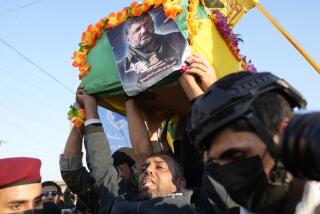Wartime Benefit: Services Cooperating
ON BOARD THE USS CARL VINSON â In the daily hunt for targets near the Taliban stronghold of Kandahar, Navy pilots are receiving valuable assistance from what might once have seemed an unlikely source: Army air controllers in Afghanistan.
For half a century, Pentagon doctrine has preached cooperation among all branches of the military. Still, that goal has often proved elusive. The competition between the Army and Navy, for example, is not limited to an annual football game between their two academies.
Ad Hoc Campaign Forces Coordination
Cooperation has been hampered by the differing technologies and missions of the individual services and sometimes by personality clashes and interservice suspicion.
But the war on terrorism, particularly the ad hoc nature of much of the bombing campaign, has forced the Army and Navy, and the Navy and Air Force, to coordinate their strategies and their strengths. While many of the details are secret, enough is known to suggest a significant abandonment of traditional rivalries.
Over a secure frequency, with voices scrambled to prevent enemy eavesdropping, Navy pilots from this workhorse carrier are in constant contact with Army Special Forces controllers who quietly entered Afghanistan weeks ago to scout targets.
âIn this war, weâre both adapting,â said Capt. Charles âSnapperâ Wright, commander of the eight air squadrons aboard the Vinson in the Arabian Sea. âEverybody has had to throw out the parochial thinking that they may have come in with.â
Wright, a 1979 Annapolis graduate and a veteran fighter pilot, enjoys the irony that it has taken a war to create a spirit of cooperation often lacking in peacetime.
âWhoâd have thought it, the Navy and Army working together?â Wright said, laughing. âYou know, sometimes things work best when you donât have any other way to do them.â
Even in an era of computer-guided weaponry and of satellite imagery that assists with target selection, much of the communication from the forward observers to the pilots is akin to directions given to a tourist in a big city: Go up two valleys, turn left and look for the second, not the first, bridge.
When the moment is propitious for an airstrike--if Taliban forces are unexpectedly massed, for example--a forward observer can give a cryptic order to circling planes: âIâm ready for some players here.â
On a weekend bombing run over the southern city of Kandahar, Wright, flying an F-14 Tomcat, had just struck a cluster of buildings thought to be Taliban structures when a Special Forces controller, watching from nearby, alerted him that Taliban vehicles were on the move.
âWe just rolled back in, looked down and saw these vehicles that looked like circus cars with guys jumping out everywhere,â Wright said. âWe were able to make another strike. Those forward controllers are doing a great job.â
Navy pilots have also had help from Air Force refueling planes in making the long journey from their carriers to landlocked Afghanistan and then remaining aloft as they wait for targets to open up.
Navy and Air Force planes have coordinated joint airstrikes.
âWe combined their [intelligence] capability with our weapons,â Wright said of a recent Navy-Air Force mission, adding that details will have to wait until the war is over.
The war is also providing an opportunity to test newly upgraded systems on Tomcats, F/A-18 Hornets and other warplanes. Of particular significance is an improved forward-looking infrared system that picks up heat patterns on the ground for targeting.
âTen years ago, we could not pick up a human being on the ground,â said Cmdr. Dave Randle, in charge of aviation maintenance on the Vinson. âToday, weâll find you, even if youâre hiding in a cave.â
Short-Timers on Guard Against Complacency
With the Vinsonâs time on station waning--the carrier John C. Stennis is expected to arrive as its relief within days--Wright and the Vinsonâs commanding officer, Capt. Rick Wren, are on guard against any tendency to drop what the Navy calls âsituational awareness.â
âWe have not slowed down, and we do not intend to,â Wren told the crew Monday night in a post-dinner address.
Wright was deputy commander of the Vinson air group when the war began and flew some of the first combat missions. He was recently elevated to commander in a routine change of command scheduled long before the first bomb was dropped.
One of the first things he did after assuming command from Capt. T. C. Bennett was to schedule himself for a mission.
âItâs the best way to know whatâs going on: Go see for yourself,â he said.
Wright warns his pilots--more than half of whom are on their first overseas deployment--not to be distracted by the political struggles about Afghanistanâs post-Taliban future.
âI want them to focus entirely on the day-in-day-out of getting the job done,â Wright said. âI donât want them to lose focus by being concerned about what the interim government in Kabul [the Afghan capital] will look like or what is happening in Bonn [where discussions on an interim government are underway]. Thatâs Central Commandâs problem, the Department of Defenseâs problem. Our problem is hitting targets.â
More to Read
Sign up for Essential California
The most important California stories and recommendations in your inbox every morning.
You may occasionally receive promotional content from the Los Angeles Times.










